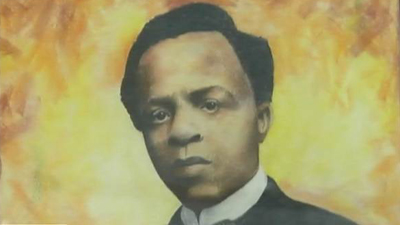A politician, a journalist, a human rights campaigner, and novelist – Solomon Tsekisho Plaatje, known as Sol Plaatjie, was born in Doornfontein near Boshof, in the Free State in 1876. He moved to Kimberley in the Northern Cape in 1894.
Throughout his life, Plaatjie devoted himself to fighting the unjust system of apartheid. He was a founder and first General Secretary of the South African Native National Congress (SANNC), which later became the African National Congress (ANC).
As a member of SANNC, Plaatjie would travel overseas to countries including England, Canada and the United States to protest the Natives Land Act of 1913 in an effort to fight for the rights of African people in South Africa.
He died in June of 1932, and was buried in the West End Cemetery in Kimberley.
In 1992 his home in Kimberley was declared a national monument and it became a museum and library.
Gontse Chaane, a researcher based at the Sol Plaatjie museum, says during the heritage month many people have come to the museum to learn more about Sol Plaatjie.
“Most of the visitors that we get round about this time of heritage month is mostly schools, where educators are teaching kids about their heritage. Sometimes they are researchers from different universities and also people that come from abroad that want to find out more about Sol Plaatjie. Mostly it’s about his writings, because other than being a political figure, he is also known for writing. So most people that come to visit are interested in his literal work,” says Chaane.
We never got much of knowledge about him that maybe we have this because of Sol Plaatjie…
Plaatjie was the first Black South African to publish a novel in English and he also translated Shakespearean plays into Setswana.
He was also one of the most influential people involved in early African newspapers.
Gopolang Plaatjie, spokesperson for the Plaatjie Trust says although Plaatjie is largely recognised for his role in the struggle, there was much more to the man.
“As a musician, he was the first person to actually record on a xonophone Nkosi Sikelel’ iAfrika. The second element which very few people know is that he wrote the Sesotho version of Nkosi Sikelela Africa, which was written by Enoch Sontonga in Xhosa. He also sang a number of hymns. There is one particular hymn which is called Outstanding which I would say is an unofficial anthem of our clan as Barolong.”
Kimberley residents say they believe not enough has been published about Sol Plaatjie.
“I don’t remember anything. I don’t have an understanding, or I don’t know much him. We never got much of knowledge about him that maybe we have this because of Sol Plaatjie,” says one of the residents.
Plaatjie’s work and life influenced many and this is one of the reasons why the Sol Plaatje Local Municipality in the Northern Cape was named after him, as is the new Sol Plaatje University in Kimberley which opened its doors this year.
– By Sellwane Khakhau


